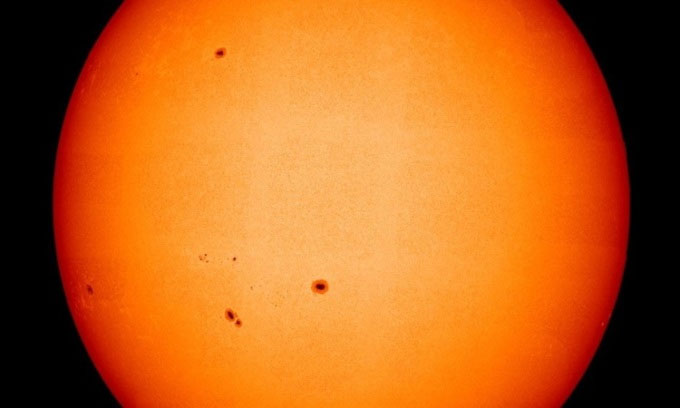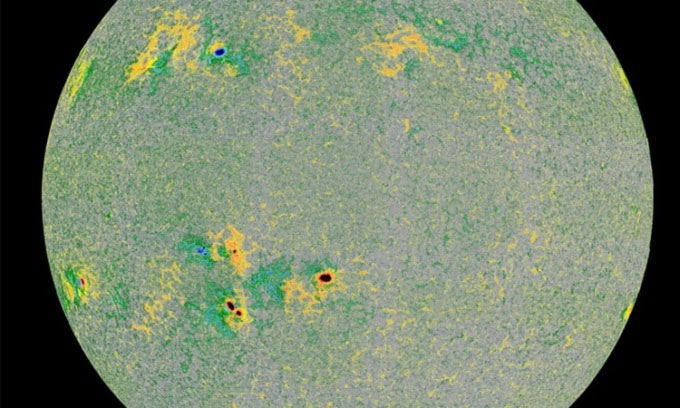The clearest picture of the Sun's surface
Solar Orbiter has sent back to Earth the highest resolution images of the Sun's surface to date, revealing many of the star's mysteries.
On November 20, the European Space Agency (ESA) shared four photos taken by the Solar Orbiter spacecraft in March last year, when the spacecraft was 74 million kilometers from the Sun. These photos capture details of the Sun's rough surface called the photosphere , the layer that emits the light we see.

Sunspots on the smooth surface of the Sun. (Photo: ESA).
The Solar Polarimetric and Seismic Imager (PHI), one of six instruments on board, captured the particles scattered across the surface. These are large, turbulent pockets of plasma, each about 1,000 kilometers across. They are created by convection, the process by which hot plasma rises from below and cooler plasma sinks from above, much like bubbles forming and rising in a pot of boiling water. The pockets cover the entire surface of the Sun, except for sunspots, the darker, cooler areas that appear like pimples against the smooth background of the photosphere.
The image below is a new map of the Sun's magnetic field, also from PHI. It reveals that the magnetic field is particularly strong and concentrated in the sunspot region. This helps explain why the sunspot is cooler than its surroundings. The extremely strong magnetic field there restricts the normal convection of plasma, forcing matter to move along the magnetic field. As a result, some of the heat is not transferred to the surface, making the sunspot cooler than other parts of the Sun's surface, says Daniel Müller, ESA's Solar Orbiter project scientist.

Direction of the magnetic field on the Sun's disk. (Image: ESA).
Another new map, called a tachogram, shows the speed and direction in which material on the Sun's surface moves. The blue region moves toward Solar Orbiter while the red region moves away from it, revealing the Sun's rotation on its axis. The solar wind escaping from the outer atmosphere, called the corona, was also captured last March by Solar Orbiter's Extreme Ultraviolet Imager (EUI) .

Map of the direction and speed of material on the Sun's surface. (Image: ESA).
Solar Orbiter is currently 120 million kilometers from the Sun, outside the orbit of Venus. Together with NASA's Parker Solar Probe, it has recently provided new clues about how solar wind heats up and accelerates to incredible speeds in space. The probe launched in 2020 as part of a joint European-NASA mission to collect unprecedented images of the Sun's poles. In early 2025, the spacecraft's orbit will allow it to reach a higher elevation angle and observe the Sun's poles directly.
- Video: 3 suns together in Russia
- The image of '2 suns' appeared in the sky of Hanoi
- Hypothesis of the fate of the Earth if the universe exists 2 Sun.
- Discovered a strange planet with 3 Suns in the summer that lasted up to 300 years
- The first clear picture of planet formation
- For the first time, the planet has 4 suns
- The fake life in the solar system has 2 suns?
- See the 'clearest photo ever' of the Sun
- The phenomenon of 'two suns' appears again in Quang Ngai
- The picture has 'ghost': Suddenly an extra person appears thanks to a cut
- Top 15 strange natural phenomena (2)
- 3 suns appear at the same time - Mysterious premonitions or scientific phenomena?
 Van Allen's belt and evidence that the Apollo 11 mission to the Moon was myth
Van Allen's belt and evidence that the Apollo 11 mission to the Moon was myth The levels of civilization in the universe (Kardashev scale)
The levels of civilization in the universe (Kardashev scale) Today Mars, the sun and the Earth are aligned
Today Mars, the sun and the Earth are aligned The Amazon owner announced a secret plan to build a space base for thousands of people
The Amazon owner announced a secret plan to build a space base for thousands of people